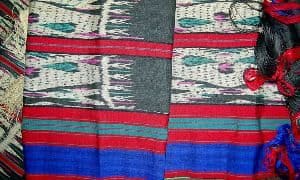 Indonesia has several kinds of distinct culture and characteristic of the place for each region. For example batik cloth and woven fabric which is quite famous in Indonesia. Weaving is a technique in making fabrics made with a simple principle, that is by combining the threads in the elongated and transverse way. In other words the cross between the warp and the feed alternately. Woven fabrics are usually made of wood fibers, cotton, and silk
Indonesia has several kinds of distinct culture and characteristic of the place for each region. For example batik cloth and woven fabric which is quite famous in Indonesia. Weaving is a technique in making fabrics made with a simple principle, that is by combining the threads in the elongated and transverse way. In other words the cross between the warp and the feed alternately. Woven fabrics are usually made of wood fibers, cotton, and silk
The art of weaving is closely related to the system of knowledge, culture, beliefs, the natural environment, and the system of social organization in society. Because the social culture in society varies, the art of weaving in each region has a difference characteristics. Therefore, the art of weaving in society has always been a particular type and is part of the cultural representation of that society. The quality of the weave is usually seen from the quality of the material, the beauty of the color, the motif, and the yarn of the ornament
See Also
- Javanese Batik Fabric
- Indonesian Ikat Fabric
- Most Beautiful Fabrics in Indonesia
- Indonesian Fashion Designers
- What to Wear in Indonesia
A. Type
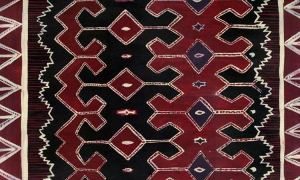 As part of the cultural system in society, weaving fabric results related to aesthetic aspects, traditional ceremonies, religious custom and status symbols that the tribe might have in their community.
As part of the cultural system in society, weaving fabric results related to aesthetic aspects, traditional ceremonies, religious custom and status symbols that the tribe might have in their community.
This, in turn, make Woven fabrics that are pretty common in Indonesia and have many different types that’s unique, especially for those woven fabric type that mainly exists in following places
- Java
- Sumatra
- Kalimantan and
- Sulawesi
with their own unique type of woven pattern. Normally, the production of woven fabrics is made on a household scale. Certain yeast shades usually contain certain meanings as well. Therefore, the art of weaving of a society is always of a particular nature and part of the cultural representation of that society
B. How to
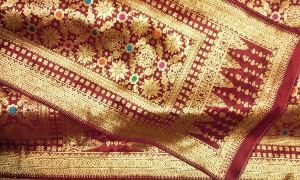 Weaving is the process of making woven fabrics from crossing two sets of threads by inserting transverse threads on warp threads (warp yarns). Before weaving is done, the Weaver put the installation of warp threads parallel to each other in the loom according to the width of the desired cloth.
Weaving is the process of making woven fabrics from crossing two sets of threads by inserting transverse threads on warp threads (warp yarns). Before weaving is done, the Weaver put the installation of warp threads parallel to each other in the loom according to the width of the desired cloth.
The loom is used to hold the strands of the warp thread while the feed thread is inserted transversely between the strands of the warp thread. Crossing patterns between warp threads and weft yarns are called webbing.
See Also
C. Best Place Production
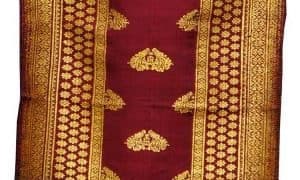 Some areas that are well known for best woven fabric production are West Sumatra, Palembang, and West Java.
Some areas that are well known for best woven fabric production are West Sumatra, Palembang, and West Java.
Some people may wonder about the development of woven fabric in Indonesia. This is normal due to weaving began to be in high demand today. In fact, there are quite a number of designers who use woven fabrics for works they create such as clothing, scarves, and for other accessories.
Songket woven fabrics often become a very popular custom fabric, especially in Sumatra region. Jambi and Palembang are two areas that many wear this type of cloth in various events. Not surprisingly, the songket originally developed because of the arrival of Chinese traders to Sumatra who sells gold silk. From Sumatra, then the gold silk spread also to Sulawesi so that in this area you also can find many songket with the beautiful motif.
Basically, both songket and ikat weaving do not differ much. Both are made by weaving two types of nodes that made the vertical and horizontal line through the help of tools and wooden blades. However, in songket, there are additional techniques in the form of hills techniques, in which there are parts of the thread that before woven to other threads are lifted and half twisted first using a tool. However, this technique has no major effect on songket texture. The most distinguishing songket with the usual type of woven fabric is due to another type of yarn that was used. In songket, there is always a gold thread or silver thread adorned on the surface of the fabric.
See Also:
- History of Art in Indonesia
- Kecak Dance In Bali
- Nias Culture
- Historical Place in Indonesia
- Table Manners in Indonesia
D. Characteristics of Every Fabric
Each fabric of Woven clothes produces different results in pattern and it’ll be based on the area of the Woven fabric is coming from. It’ll be explained below for better understanding
1. Ulos Weaving
 Ulos or often also called ulos cloth is one of the typical Indonesian fashion. Ulos is hereditarily developed by the Batak community, North Sumatra. From the language of origin, ulos means cloth. How to make ulos similar to how to make a typical songket Palembang, which uses a loom instead of a machine.
Ulos or often also called ulos cloth is one of the typical Indonesian fashion. Ulos is hereditarily developed by the Batak community, North Sumatra. From the language of origin, ulos means cloth. How to make ulos similar to how to make a typical songket Palembang, which uses a loom instead of a machine.
The dominant colors on ulos are red, black, and white decorated by the woven variety of gold or silver threads. Ulos initially worn in the form of a scarf or sarong only, often used in official events or ceremonies of Batak people, but now often found in the form of souvenir for prop pillow cases, belts, bags, clothing, table mats, ties, wallets, and curtains .
2.Gringsing Weaving
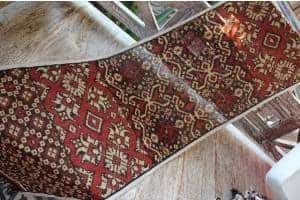 Gringsing fabric is the only Indonesian traditional woven fabric that is made using double technique and takes 2-5 years. This fabric comes from Tenganan Village, Bali. Generally, the community has a hundred-year-old gringsing cloth used in special ceremonies. The word gringsing comes from gring meaning ‘pain’ and sing which means ‘no’, so when combined with ‘not pain’. The intent contained in the word is like a repellent of fallacy. In Bali, ceremonies, such as tooth-cutting ceremonies, weddings, and other religious ceremonies, are performed by relying on the strength of gringsing fabrics.
Gringsing fabric is the only Indonesian traditional woven fabric that is made using double technique and takes 2-5 years. This fabric comes from Tenganan Village, Bali. Generally, the community has a hundred-year-old gringsing cloth used in special ceremonies. The word gringsing comes from gring meaning ‘pain’ and sing which means ‘no’, so when combined with ‘not pain’. The intent contained in the word is like a repellent of fallacy. In Bali, ceremonies, such as tooth-cutting ceremonies, weddings, and other religious ceremonies, are performed by relying on the strength of gringsing fabrics.
See Also
- Fruits of Indonesia
- Religious Beliefs in Indonesia
- Trade in indonesia
- Spices in Indonesia
- Indonesian Cultural Festival
3. Lurik Weaving
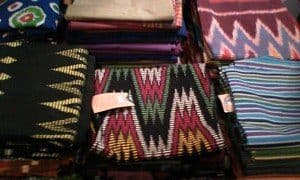 The striated cloth is one of the woven fabric of the archipelago that grows and develops in Java Island.
The striated cloth is one of the woven fabric of the archipelago that grows and develops in Java Island.
And there have been various historical discoveries showing that lurik weaving has existed in Java since prehistoric times. This can be seen from the various inscriptions that remain, such as the Mataram Kingdom Religion (851 – 882 AD) inscription denotes the existence of poor lurik feed. The inscription of King Erlangga from East Java in 1033 mentions tuluh watu, one of the striated lurik. And further, reinforce the notion that weaving has long been known in Java and the use of woven fabrics on the statues and temple reliefs are scattered throughout the island of Java.
Others (4-7)
Meanwhile, there are severral type of weaving technique from Indonesia which stil used for produce a best quality of fabric, as follows:
4. Sumba Weaving: Sumba weaving is one of the art forms of handicraft produced by the woman from sumba, NTT. The weaving craft is a beautifully decorative piece of cloth, with an attractive design, harmonious composition, and decorative shapes that have their own characteristics.
5. Toraja Weaving: Toraja Woven Fabrics is a symbol that is typical of human attachment to nature and its environment and one of the ancestral heritage that is still on guard for its preservation to date.
6. Ikat Troso Weaving: Troso trouser or troso cloth is a Jepara weaving craft precisely from the village of Troso and in the form of cloth woven from strands of weft yarn or warp threads previously tied and immersed in natural dye. The looms used are non-machine looms. Tied fabrics can be sewn to be used as clothing, furniture upholstery, or home interior decorator.
7. Buna Insana Weaving: Woven fabric from NTT is a woven fabric full handmade which is currently in the search by the fans of woven cloth in the archipelago. Buna fabrics with beautiful colors are perfect as a buna weaving bag, woven clothes, and various other souvenirs.
See Also:
- Indonesian Folk Dance
- History of Art in Indonesia
- Piracy in Indonesia
- Eating Habits in Indonesia
- Largest Islands in Indonesia
E. Characteristics of Every Weaving Technique
In the weaving-making process, there are some basic techniques commonly used. The use of this basic technique shall be in accordance with the purpose of making the weave. The 3 basic techniques in this weave consist of simple techniques, twill techniques, and special techniques. Here’s an explanation of 3 basic techniques in weaving:
1. Simple weaving technique
Simple weaving technique is a basic technique in weaving that’s the oldest and the simplest. The process of making use of this technique is each of the threads is fed up and down alternately while crossing each other. This woven fabric is very strong and widely used
2. Twill weaving techniques
In twill weaving techniques, the cross-feed yarn under two lungsing threads and above a lungsing yarn alternately. It shows that the three-woven fabric is the simplest. Furthermore, there is a complete web, which consists of 3 threads of feed and a lunsing thread. In twill weaving techniques, there is a meeting point between the lungsing thread and the feed (weaving point) that goes tilted. This will create a slash pattern on the woven fabric.
3. Special weaving technique
Other weaving methods can be grouped into specialized weaving groups. Specific weaving types such as using additional feed (songket technique) and additional warp. Songket weaving is a weaving technique by adding other materials into the fabric structure. Commonly used additives are gold, silver or copper yarn. Sometimes the manufacturer of this woven fabric is combined with the connective technique. Examples of songket woven fabrics are in South Sumatra, Bangka woven fabrics, West Sumatera, Lampung, and Jambi. To get the desired motif, an ornamental pattern plan is required by including some additional design.
See Also:
The woven fabrics shares unique traits personality that signifies the culture that each tribe has. By wearing this woven fabric in everyday clothing then Indonesian people can help to try to preserve their enormous heritage to pass down to future generations so that the technique of weaving fabric won’t be lost. Thus it can bring in more commerce or tourism revenue for many people living there.